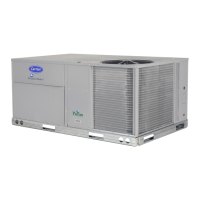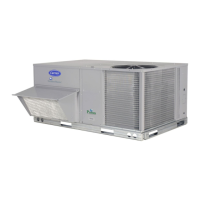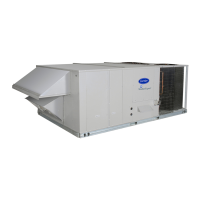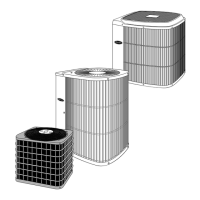Fancoil Installation Instructions for setting required airflow.) This
fan coil has an adjustable blower off delay factory set at 90 sec. for
high- and low-speed blower operation.
For other combinations of equipment consult the Product Data
Digest.
Step 11—Start-Up
To prevent compressor damage or personal injury, observe
the following:
• Do not overcharge system with refrigerant.
• Do not operate unit in a vacuum or at negative pressure.
• Do not disable low-pressure switch.
To prevent personal injury wear safety glasses, protective
clothing, and gloves when handling refrigerant and observe
the following:
Back seating service valves are not equipped with Schrader
valves. Fully back seat (counter clockwise) valve system
before removing gage port cap.
Do not vent refrigerant to atmosphere. Recover during system
repair or final unit disposal.
Follow these steps to properly start up the system:
1. The outdoor unit is equipped with a crankcase heater which
operates when the compressor is OFF. Energize crankcase
heater 24 hr before starting unit. To energize heater only, set
indoor thermostat to OFF position and close power disconnect
to unit.
NOTE: Starting the compressor without a minimum of 12 hr of
crankcase heat prior to initial start-up, may result in compressor
chattering and possible damage to the compressor.
2. Fully back seat (open) liquid and vapor tube service valves.
3. Unit is shipped with valve stem(s) front seated and caps
installed. Replace stem caps after system is opened to refrig-
erant flow (back seated). Replace caps finger tight and tighten
additional 1/12 turn (20 ft-lb torque) with wrench.
4. Close electrical disconnects to energize system.
5. Set room thermostat at desired temperature. Be sure the set
point is below indoor ambient and is set low enough to
energize desired speed.
NOTE: Carrier electronic thermostats are equipped with a 15-
minute staging timer. This timer prevents the dual capacity system
from operating at high capacity until unit has been operating in low
capacity for 15 minutes unless there is at least a 5°F difference
between room temperature and thermostat set point. To force high
capacity, adjust the set point at least 5° below room ambient for
cooling or 5° above room ambient for heating.
6. Set room thermostat to COOL or HEAT and fan control to
AUTO or ON as desired. Wait for appropriate time delay(s).
Operate unit for 15 minutes. Check refrigerant charge.
NOTE: If unit has not operated within the past 12 hr or following
a unit power-up, upon the next thermostat high- or low-speed
demand, unit operates for a minimum of 5 minutes in high-speed.
Step 12—Check Charge
Service valve gage ports are not equipped with Schrader
valves. To prevent personal injury, make sure gage manifold
is connected to the valve gage ports before moving valves off
fully back seated position. Wear safety glasses and gloves
when handling refrigerant.
UNIT CHARGE
Factory charge is shown on unit rating plate. With unit operating,
charge Puron® units with liquid using a commercial type metering
device manifold hose. Charge refrigerant into suction line. To
check charge in cooling mode, refer to Cooling Only Procedure.
To check charge in heating mode, refer to Heating Check Chart
Procedure.
Adjust charge in both heating and cooling by following procedure
shown on charging tables located on unit pink charging label on
back side of access panel.
NOTE: Unit is to be charged in high capacity only. Charging in
low capacity may cause compressor chattering and possible
damage to the compressor.
COOLING ONLY PROCEDURE
1. Operate unit a minimum of 15 minutes before checking
charge.
2. Measure liquid service valve pressure by attaching and insu-
lating an accurate Puron® gage to service port.
3. Measure liquid line temperature by attaching an accurate
thermistor type or electronic thermometer to liquid line near
outdoor coil.
4. Refer to charging label for required subcooling temperatures.
5. Refer to Table 3. Find the point where required subcooling
temperature intersects measured liquid service valve pressure.
6. To obtain required subcooling temperature at a specific liquid
line pressure, add refrigerant if liquid line temperature is
higher than indicated or reclaim refrigerant if temperature is
lower. Allow a tolerance of ± 3°F.
HEATING CHECK CHART PROCEDURE
To check system operation during heating cycle, refer to the
Heating Pump Charging Instructions on outdoor unit. This chart
indicates whether a correct relationship exists between system
operating pressure and air temperature entering indoor and outdoor
units. If pressure and temperature do not match on chart, system
refrigerant charge may not be correct. Do not use chart to adjust
refrigerant charge.
NOTE: In heating mode, check refrigerant charge only when
pressures are stable. If operating conditions cause vapor pressure
switch and thereby outdoor fan to cycle, check refrigerant charge
in cooling or lower indoor dry bulb temperature. If in doubt,
remove charge and weigh in correct refrigerant charge.
NOTE: When charging is necessary during heating season,
charge must be weighed in accordance with unit rating plate ±0.6
oz/ft of 3/8-in. liquid line above or below 15 ft respectively.
EXAMPLE:
To calculate additional charge required for a 25-ft line set:
25 ft - 15 ft = 10 ft X 0.6 oz/ft=6ozofadditional charge
Step 13—System Functions and Sequence of Operation
The outdoor unit control system has special functions. The
following is an overview of the two-speed control functions:
7
→

